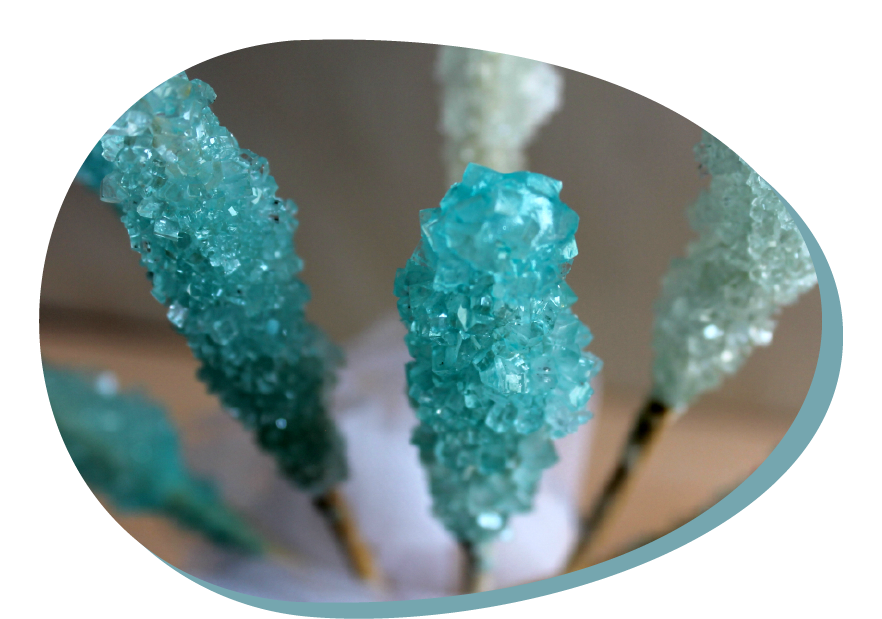Magic Wands
Type of resource: website (blog)
Web address https://blog.giallozafferano.it/annacreazioniincucina/rock-candy/#google_vignette
Language: IT
Description
Enabling students to familiarise themselves with the changes of state of matter
Scientific concept introduced
solution, saturation, solid, liquid, food colouring, crystals, fusion
Creative and critical thinking
Critical thinking:
1. Analysing
2. Observe
Creative thinking:
1. Originality
2. Curiosity
3. Imagination
Mathematical reasoning
Classifying, Measuring
Scientific thinking
Observing, asking questions, formulating hypotheses, testing hypotheses, analysing results
Learning how to learn
To plan and carry out an experiment, to investigate the solubility of a solution, to follow the steps of a procedure exactly, to present and document the experiment carried out, to feel self-efficacious, to make an original product
Additional
Hand-eye coordination
Fine manual dexterity
Precision and efficiency of movement
Listening and understanding
Magic Wands
Overall aims
– enable students to familiarise themselves with the changes of state of matter
– enable students to familiarise themselves with the behaviour of liquids in the event of saturation
– stimulating students to improve their fine manual skills
– developing students’ ability to follow instructions carefully
– developing students’ aesthetic sense in the creation of ‘sugar sticks’.
– developing students’ ability to present and document their achievements
Vocabulary – keywords should be understood
water, sugar, solution, saturation, solid, liquid, food colouring, crystals, melting.
Expected learning outcomes (operational aims)
the child/student will be able to:
– carry out an experiment
– explore transitions of matter states and the concept of saturation of solutions
– tell the story of the experiment
the child/student will have developed the ability to:
– Exactly following the steps of a process
– Making scientific observations
– Making an original product
STEM skills – to which the learning unit is related to
CORE STEM SKILLS
Observe
Asking questions
Formulating hypotheses
Experiment
Check the assumptions
Analysing the results
ADDITIONAL SKILLS
Hand-eye coordination
Fine motor skills Fine dexterity
Precision and efficiency of movement
Listening and understanding
Teaching methodologies/activity outline
1. Show the children/young people the materials they will need to carry out the experiment and tell them: “What do you think we will make today with sugar and colouring?” “What work of art can we create?”
2. “Magic Wands’ is the name of the experiment we are going to carry out today.
3. The experiment will explore state transitions and saturation of liquids.
Activities:
After explaining the experiment to the pupils, the teacher gives them all the materials needed to carry out the experiment and guides them through the activity.
Material:
Water
Caster sugar
Tall glass beakers (one for each pupil)
Food colouring (red, blue, yellow, green, violet)
Laundry clips
Skewer sticks (one each)
Scales
Aromas
Spoon (one each)
Scoop
Instructions:
1. Using a measuring cup, take the right amount of water (200 ml) and with the help of the teacher pour it into a pot and bring it to the boil. How can we tell that the water has really come to the boil?
2. While the water is boiling, we fill a glass with 100 ml of water and then add 300 g of sugar and stir. Does the sugar dissolve? Why?
3. When the water boils, pour in 600 g of sugar and stir to dissolve it. Does it dissolve this time?
4. Keep the pan on a medium heat for 3-4 minutes and bring back to the boil so that the sugar dissolves well.
5. Switch off and let the syrup rest for twenty minutes.
6. Take the toothpicks and dip them in the syrup and then roll them in caster sugar.
7. Let it dry so that the sugar crystals stick better, then take the toothpicks and attach them to clothes pegs so that when you place them on the glasses they will hold the toothpicks 2.5-3 cm from the bottom.
8. We temporarily move the toothpicks and then pour the dye of our choice into the bottom of the glass.
9. Pour the syrup into the glass and mix it with the colouring.
10. Put the sticks back on the clothes pegs and leave them for a few days (3-5).
11. If a hard layer has formed on the surface, simply break it gently and then pull out the ‘sticks’ when they have formed.
12. We are careful to allow the excess syrup to drip into another glass.
13. We have now obtained our ‘sugar sticks’.
Conclusions:
At the end of the activity, the teacher can propose to taste the sugar sticks, stimulate through questions a debriefing activity and then invite the children to describe orally their own stick as it appears to touch, taste and sight.
Assessment of learning
It is implemented through observation of the activity by the teacher who assesses pupils’ commitment and participation.
Equipment and materials to be used in learning unit (tools, ingredients etc)
– Water
– Caster sugar
– Tall glass beakers
– Food dyes
– Laundry clips
– Skewer sticks
– Libra
– Flavours
– Spoon
– Measuring cup
-Pan
-Fornelletto
Kind of setting
Science laboratory
References – source
ROCK CANDY
Magic Wands
1. Usefulness for STEM education – integrating content of different disciplines
Cross-curricular character of the resource

The range of S-T-E-M subjects included

The presentation of possibilities of including artistic activities (STEAM approach)

2. Expected learning outcomes
Consistency (links) with preschool core curriculum

Communicativeness of description

3. Methodology of teaching
Clarity, communicativeness of instructions for teachers

Meaningful learning – using practical life problems

Original idea

The level of ease in implementing the methodology to preschool age children

The level of ease in preparing necessary ingredients, materials and equipment needed

4. Sustainability
Ecological characteristics of materials/ results

Supporting healthy eating habits

Low ecological footprint

Possibilities of inclusion (respecting cultural diversity and food intolerances)

5. Class management
Using differentiated forms of work – individual, team work etc.

Individual work

Team work

Whole group
6. Time management

Short activity (10-15 minutes)

Medium activity (20-30 minutes)

Long activity (1 hour or more)

Very long activity (1 day or more)
PDF: https://www.printfriendly.com/p/g/NEj5iB

